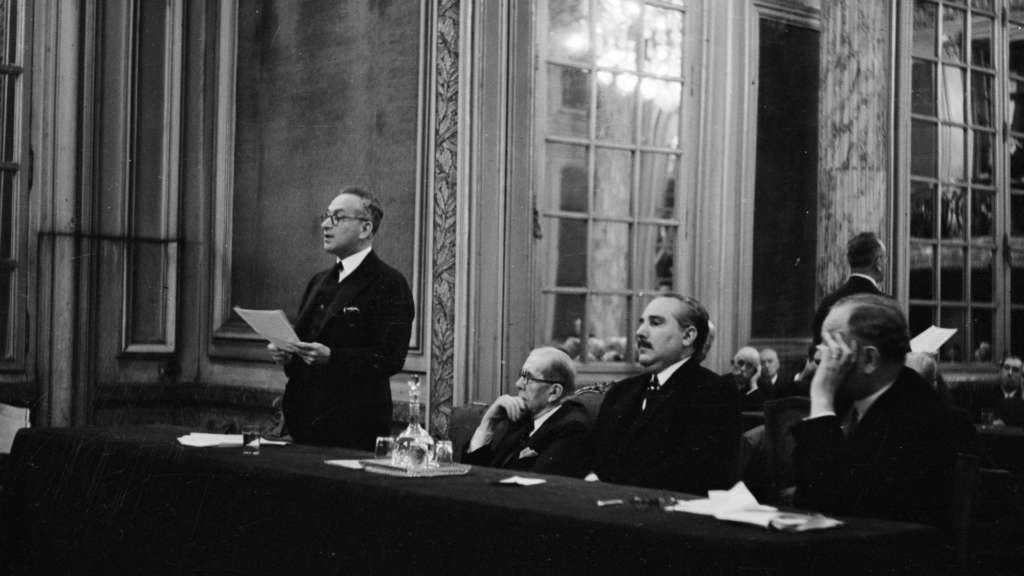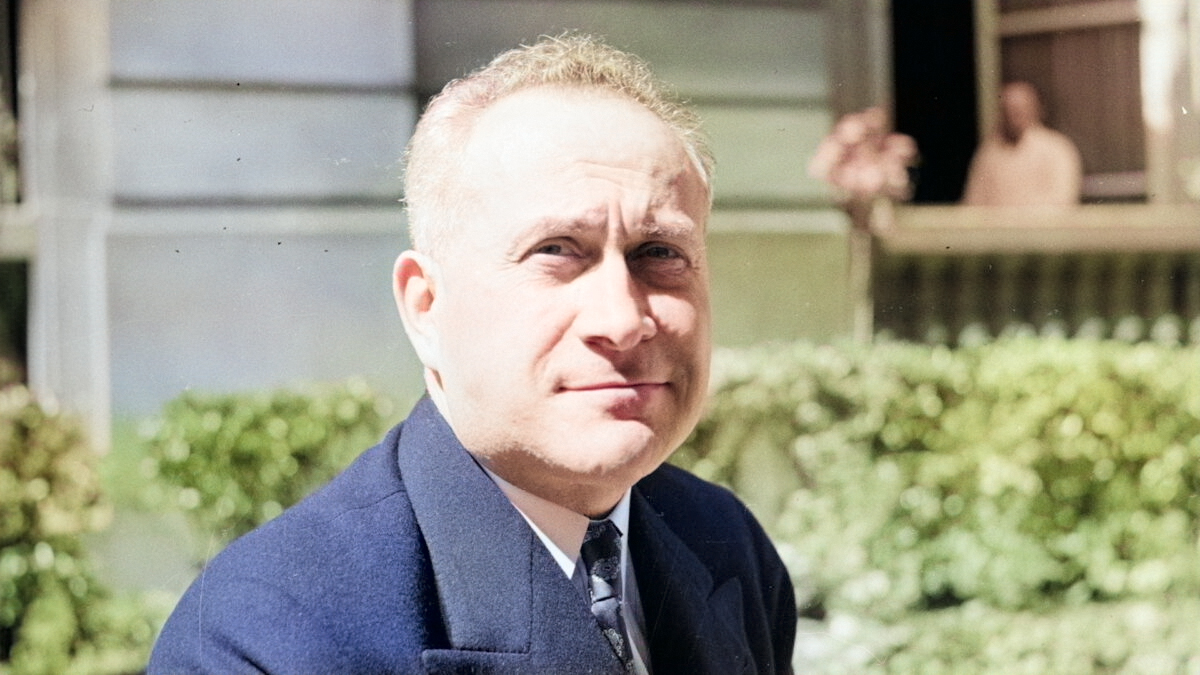In the poll for the „Greatest Slovak“, he did not even place in the top 100 personalities. In Bratislava’s Petržalka, an inconspicuous street is named after him, where you can buy langoustines and ice cream in the summer. Slovaks know so little about a man whose signature – as the signature of a single Slovak – is on the Treaty of Trianon. A prominent First Republic diplomat who became involved in the League of Nations and, as one of the few politicians of his time, realized its importance when he said: “Will modern civilization understand that its salvation is in a common organization? If so, it will win; if not, signs the death sentence by itself.” Meet Štefan Osuský.
Reading time: 25 minutes
Contents
- Excessively ambitious Slovak from America
- Trianon Peace Treaty
- Štefan Osuský – successful abroad, unknown at home
- The truth about the Munich Agreement
Excessively ambitious Slovak from America
We meet the name Štefan Osuský in 1916, when he came to Europe from America together with Gustav Košík to help T. G. Masaryk, Milan Rastislav Štefánik and Edvard Beneš in organizing the Czechoslovak foreign resistance. He was 27 at the time and practiced law at Sinden, Hassell & Osusky.
In America, he became involved in compatriot life, publishing the newspapers „Slovenské slovo“ (Slovak word) and „Slovenský týždenník“ (Slovak weekly), which he co-financed with his brother-in-law.
He was sent to Europe by American Slovaks associated in the Slovak League as their evangelical representative. He reached Masaryk on an adventurous journey without valid travel documents in June 1916.
He was sent to Europe by American Slovaks associated in the Slovak League as their evangelical representative. After his adventurous journey without a passport, he reached Masaryk in June 1916.
Osuský was better and more sensible, though poorly educated.
Tomáš Garrigue Masaryk
I tried to raise him. He came to me every day. Then I sent him to Beneš in Paris. Mr. Košík was worthless. I saw that right away.
Masaryk describes a meeting with Štefan Osuský to his archivist Anne Gašparíková-Horáková.
Edvard Beneš quickly gets into a conflict with a new colleague. Energetic Osuský did not leave his legal practice in America to take an insignificant place in the Czechoslovak resistance. Beneš is surprised by the ambitions of the American Slovak.
I had a lot of problems with Osuský. He thinks we’re overlooking and downplaying Slovaks.
Edvard Beneš
He wrote to Masaryk in the autumn of 1916. The conflict continued in the first months of the following year. Beneš writes:
I ask him for documents and an explanation. He begins to rage – in the true sense of the word ‚rage‘.He shouts that I will not treated with him like a rag. He will not pay my respects to me. He told me I was insulting him and not letting him work. He has had enough. He spoke rude. He imagined that he would play the main role and that he would represent the Czechoslovak foreign resistance. His ambitions were offended.
Edvard Beneš
The relationship between the two men will never improve. It will go through various crises until 1942, when their paths will diverge permanently.
However, Osuský manages to win his place in the sun. Thanks to him, the Czech National Council is renamed the Czechoslovak National Council. While working in Beneš’s office, a linguistically gifted lawyer will learn French and in the autumn of 1917 he will travel to Geneva – the then center of European affairs. In Switzerland, he will meet with a confidant of US President Wilson, Professor George D. Herron. Their intensive cooperation eventually leads to the American president becoming a supporter of the idea of liberating the small nations of Austria-Hungary.
Štefan Osuský is also present at another important milestone in the Czechoslovak foreign resistance. In Italy, together with Milan Rastislav Štefánik, he represents Slovaks at the Congress of Oppressed Nations. It is there at a time when Štefánik is concluding an agreement on the position of the Czechoslovak legions in Italy, which is creating an autonomous army subordinate to the Czechoslovak National Council.
And it was none other than Štefan Osuský, who arranged in Switzerland a meeting of representatives of the Czechoslovak foreign and domestic resistance at the end of October 1918.

Trianon Peace Treaty
When the Hungarian Minister of Culture, Albert Apponyi, visits the Evangelical Lyceum in Bratislava in the spring of 1905, the professor of Latin chooses the most able of the pupils to show his knowledge. Sixteen-year-old Štefan makes a good impression on Apponyi, but it quickly disappears in an awkward silence. Osuský is stubbornly silent when asked if he will become a good Hungarian. The offended Apponyi will make sure that he is expelled not only from high school, but from all schools in Hungary. If he wants to get a higher education, he has to travel. He will choose America.
Even in the worst dream, Count Apponyi would not have imagined that this expelled student would sit at the negotiating table with him 15 years later. Hold … karma is free. Štefan Osuský became one of the delegates of Czechoslovakia at the Peace Conference in Paris and in 1920 he led the delegation in negotiations with Hungary. His personal motivation drove him to refute every Hungarian argument. Nevertheless, the negotiations took place in a friendly atmosphere. Osuský greeted the count in Hungarian, Apponyi answered in Slovak.
Finally, Hungary recognized the independence of Czechoslovakia, agreed on the border and undertook to return all historical, artistic and cultural monuments that were exported from our territory.
Bratislava, including the right bank of the Danube, has definitely become a part of Czechoslovakia. Although the Czechoslovak legionaries occupied it as early as December 1918, the Hungarians did not plan to give up an important transport hub so easily. In his lecture „The Place of Slovakia in the New Europe“, Štefan Osuský evaluated the significance of Bratislava for the republic as follows:
Slovakia borders four countries: Poland, Romania, Hungary and Austria, but its position on the Danube allows Czechoslovakia to contact Eastern and Southeastern Europe and free water passage through the center of Hungary into the Black Sea. For Czechoslovakia, which does not have direct access to the sea, this path is vital.
Štefan Osuský
For the present-day Slovak Republic, the Trianon Peace Treaty is a major milestone in history. Although the Czechoslovak legionaries occupied the territory of Slovakia and defended themselves against the Hungarian military attack, our borders were finally acquired at a peace conference in Paris. Although Slovakia lost part of its territory in the Vienna Arbitration in 1938, the Peace Conference after World War II reaffirmed the borders agreed in Trianon. With the exception of Subcarpathian Russia.
The solemn moment when a peace treaty with Hungary was signed in the Grand Trianon Palace was not only of national but also personal significance for Osuský. He later wrote:
The Paris press claimed that of all the delegates who signed the peace treaty, my face shone with the greatest joy …
Štefan Osuský
And who knows if Count Apponyi ever found out who he was dealing with? 🙂
Štefan Osuský – successful abroad, unknown at home
Osusky becomes a diplomat, first in London and then in Paris. It is very popular among French statesmen. Osuský is involvement in the League of Nations, in which he is not only a representative of Czechoslovakia, but also a member of several control bodies.
In the summer of 1934, Anna Gašparíková-Horáková (Masaryk’s archivist) writes in her diary:
Mr. Schreiber, a French publisher and a well-known journalist, is a well-informed person. Mrs. Schreiber is a nice pretty lady. (…) When I was alone with her once, she spoke with great sympathy about the Osuský family. ‚I don’t even know,‘ she asking me, ‚whether it is well known to you that Ambassador Osuský represents his country in a truly eminent way and that he has the great sympathy in Paris‘
Anna Gašparíková-Horáková
However, Osusky will never succeed in penetrating domestic politics. Czechoslovaks see in it a Slovak nationalist, but Slovaks see a Czechoslovakist. One evening at Lány, an interesting conversation takes place between Masaryk and his daughter Alice. The President’s archivist records it as follows:
‚He’s uninformed,‘ the president said. ‚He understands some things quite well, finance and banking, but he doesn’t know the situation here. (…) Because he doesn’t know the situation, he can’t do anything for Slovakia either. His foreign authority is, unfortunately, still dead capital.‘
After all, the doctor does not consider it a completely dead capital. She believes in the good aspects of Osuský, and in the fact that when the time comes, he can also benefit Slovakia in domestic politics.
Anna Gašparíková-Horáková
Masaryk accurately estimated Osuský’s future, and who knows if he himself had a share in it. When Edvard Beneš became the second president of Czechoslovakia in 1935, Štefan Osuský was expected to take up the post of Minister of Foreign Affairs. But it didn’t happen. Beneš chose the non-conflicting historian Kamil Krofta as his successor. Was it a fatal mistake that cost him a republic?

The truth about the Munich Agreement
The prevailing opinion among the people in the Czech Republic and Slovakia was that the Munich Agreement was a betrayal of the Western powers they had committed against Czechoslovakia. This view is based on the fact that the Western Allies annulled the Munich Agreement after the war. However, when we look at the period documents, we must admit that this view is not objective and is greatly influenced by who won the Second World War. If you have won the war, it does not mean that you are telling the truth. 🙂
The problem in the negotiations on the position of the German minority in Czechoslovakia was not only Hitler’s „fifth colony“ led by Konrad Henlein, but also the person of Czechoslovak President Edvard Beneš. He became so untrustworthy for Western politicians that until Hitler occupied France, the restoration of Czechoslovakia after the war was probably not expected at all. For the Allies, it simply became a failed project.
The allied countries of the German Empire or the countries it occupied recognized the Slovak state de facto and de jure shortly after its establishment. On May 4, 1939, the United Kingdom joined them. The British Consul explained to the Minister of Foreign Affairs Ferdinand Ďurčanský that Her Majesty recognized the newly created Slovak state de facto.
The attitude of France and Britain towards Czechoslovakia is documented by the newspaper „Slovenská obrana“ (Slovak defense) of 7 July 1939 as follows:
Osuský tried to get Czech radio by allow France. France has Turkish, Spanish, Arabic, German, English and God knows what radio, but Czech radio did not allow it, because it is said that it does not want to burn a bridge to Germany for the Czechs. (…) France and England are definitely opposed to a kind of provisional Czech-Slovak government.
Slovenská obrana, 7. 7. 1939
In the Vatican’s diary of the envoy Karol Sidor in 1940 we can read a similar record:
The French censor on the Paris radio from the sentence: ‚Poland and Czechoslovakia will be free,‘ the words ‚and Czechoslovakia‘ were erased from them. He said: „It’s not certain. Czechoslovakia in definitely won’t be in the previous form.
Karol Sidor
It might seem that the Munich Agreement, which started the disintegration and subsequent demise of Czechoslovakia, was a fatal failure of Czechoslovak diplomacy, but the truth again has slightly different coordinates. The ambassador to France, Štefan Osuský, had no idea about President Beneš’s actions. The historian Slavomír Michálek writes in his book „Diplomat Štefan Osuský“:
What France did in Czechoslovakia, Osuský called it bare murder. He visited Daladier with self-denial, only to „pray for support in solving the new Czechoslovak borders …“ (…) Daladier continued by acquainting Osuský with Nečas’s journey to Paris on September 17, 1938 and with his secret mission, in which Beneš proposed the withdrawal of 4,000 to 6,000 km2 and 1.5 to 2 million inhabitants of the republic. In this secret message from Nečas, Beneš strongly demanded that the French government not inform Osuský or discuss it with him.
Slavomír Michálek
There are several testimonies to these claims, both from French, British and Czechoslovak politicians. Edvard Beneš was therefore not in a position to take the decision of the Western Allies. He took a decision, which he himself proposed to them.
Diplomat Osuský was to become a scapegoat in Paris. The Czechoslovak pro-government press launched a campaign against him and made him responsible for the events preceding Munich. Osuský therefore returned to Prague on November 11, 1938, and overwhelmed Prime Minister General Syrový with hundreds of documents to clarify France’s position, as well as the instructions sent to him by Krofta and Beneš. The „Slovenský denník“ (Slovak diary), published by the Slovak National Council, wrote about Osuský visit:
National and state catastrophe according to dr. Osuský ‚did not fall from the sky‘, but is the work of certain persons who are responsible for it. The nation must know the truth in order to avoid falling into similar mistakes in the future. (…) France and England did not betray us, because the proposal for the division comes from Prague.
Slovenský denník, 12. 11. 1938
Osuský urges an investigation in Prague, but in the end they only investigate his. He will not receive a verdict; before the Czechoslovak bureaucratic apparatus moves, the rest of the republic will be occupied by Hitler’s troops. Štefan Osuský will be at the embassy in Paris at that time. He will become the leading figure of the second Czechoslovak foreign resistance. He will cause such problems for the Nazis in the first years of the war that they plan to assassinate him. But… that’s a different story.
Stay tuned to see next episode. 🙂
Resources:
- Trianonská mierová zmluva, 1920
- Robert W. Seton-Watson: Slovensko kedysi a teraz, 1931
- Štefan Monček: Štefan Osuský a jeho myšlienky, 1937
- Vyslanec dr. Osuský o budúcom vývoji republiky, Slovenský denník 11. november 1938
- Dr. Osuský sa vrátil do Paríža, Slovenský denník 22. november 1938
- Taliansko uznáva Slovenský štát, Slovák 12. mája 1939
- Anglicko uznáva Slovenský štát de facto, Slovák 5. mája 1939
- Osuský v českom znení, Slovenský obrana 7. júla. 1939
- Mníchov v dokumentech I., 1958
- Anna Gašparíková-Horáková – U Masarykovcov, 1995
- Slavomír Michálek – Diplomat Štefan Osuský, 1999
- Korespondence T. G. Masaryk – Edvard Beneš 1914-1918, 2004
- Karol Sidor: Vatikánsky denník I., 2011

1 komentár
Komentáre sú uzavreté.